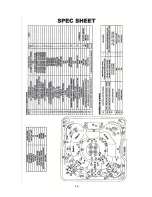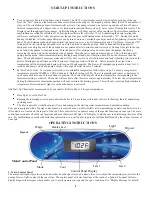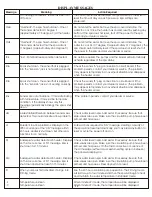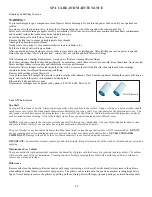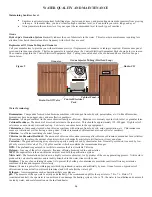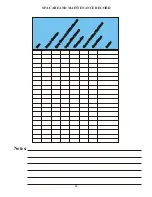
Maintaining Sanitizer Level
!
Sanitizer is extremely important for killing algae, bacteria and viruses, and preventing unwanted organisms from growing
in the spa. At the same time, you don’t want too high a sanitizer level, or it can irritate your skin, lungs, and eyes.
!
Always maintain the sanitizer level in your spa at the recommended level for each type of sanitizer.
Control Electrical
Pack
Ozonator
Ozone Injector Tubing (Hartford Loop)
Check Valve
Ozone
Hydro Spa’s Ozonation System
drastically reduces the use of chemicals in the water. This also aids in maintenance requiring less
attention from harsh chemicals and less frequency with which they are used.
Replacement Of Ozone Tubing and Ozonator
Call your manufucture to provide you with maintenance service if replacement of ozonator or tubing is required. Remove door panel
screws and set door panel aside. The Ozone generator is located above the Control Electrical Equipment Pack shown below or in area.
The ozonator plugs into the Control Electrical Equipment Pack. Tubing is mounted above the ozonator and has a Harford Loop as
shown below.
WATER QUALITY AND MAINTENANCE
Water Terminology
Bromamines:
Compounds formed when bromine combines with nitrogen from body oils, perspiration, etc. Unlike chloramines,
bromamines have no pungent odor, and are effective sanitizers.
Bromine:
A halogen sanitizer (in the same chemical family as chlorine). Bromine is commonly used in stick, tablet, or granular form.
Calcium Hardness:
The amount of dissolved calcium in the spa water. This should be approximately 150-220 ppm. High levels of
calcium can cause cloudy water and scaling. Low levels can cause harm to the spa equipment.
Chloramines:
Compounds formed when chlorine combines with nitrogen from body oils, urine, perspiration, etc. Chloramines can
cause eye irritation as well as having a strong odor. Unlike bromamines, chloramines are weaker, slower sanitizers.
Chlorine:
An efficient sanitizing chemical for spas.
Chlorine (or Bromine) Residual:
The amount of chlorine or bromine remaining after chlorine or bromine demand has been satisfied.
The residual is, therefore, the amount of sanitizer which is chemically available to kill bacteria, viruses and algae.
Corrosion:
The gradual wearing away of metal spa parts, usually caused by chemical action. Generally, corrosion is caused by low
pH or by water with levels of TA, CH, pH or sanitizer which are outside the recommended ranges.
DPD:
The preferred reagent used in test kits to measure the Free Available Chlorine.
Halogen:
Any one of these five elements: fluorine, chlorine, bromine, iodine, and astatine.
MPS:
Monopersulfate is the non-chlorine oxidizer used with the purification system.
Nitric Acid:
The formulation of nitric acid, a highly corrosive chemical, is a byproduct of the ozone generating process. Nitric acid is
produced in very small quantities and is readily dissolved in the water stream with ozone.
Oxidizer:
The use of an oxidizing chemical is to prevent the buildup of contaminants, maximize sanitizer efficiency, minimize
combined chlorine and improve water clarity.
Ozone:
Ozone is a powerful oxidizing agent which is produced in nature and artificially by man. Ozone forms no byproducts of
chloramines (ozone actually oxidizes chloramines) and will not alter the water’s pH.
Pathogen:
A microorganism such as bacterium that cause disease.
pH:
The measure of the spa water’s acidity and alkalinity. The recommended pH for the spa water is 7.4 to 7.6. Below 7.0
(considered neutral), the spa water is too acidic and can damage the heating system. Above 7.8, the water is too alkaline and can result
in cloudy water, and scale formation on the shell and heater.
16
Radio-CD
Cabinet Panel
Ozone Hartford Loop
Drain On-Off Valve
Figure 9
Summary of Contents for Platinum II
Page 1: ...Owners Manual C ...
Page 9: ...5a ...
Page 10: ...5b ...
Page 11: ...AUDIO SYSTEM CONNECTON DIAGRAM 5c ...
Page 26: ...1 8 0 0 7 4 9 8 0 0 3 6101 N 45th Street St Petersburg Florida 33714 STAMP ...



